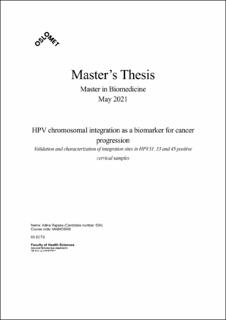HPV chromosomal integration as a biomarker for cancer progression
Master thesis
Published version
Permanent lenke
https://hdl.handle.net/11250/2836505Utgivelsesdato
2021Metadata
Vis full innførselSamlinger
Sammendrag
Background: Human papillomavirus (HPV) is associated with 4,5% of all human cancers worldwide including cervical cancer. Cytological and/or HPV primary screening is used to uncover cancer precursors. Still, better clinical specificity of screening procedures is warranted to decrease unnecessary follow-up and treatment. However, currently there is no ideal secondary diagnostic biomarker for predicting the risk of cancer progression. Viral integration is one of several reported potential biomarkers. Current HPV integration research often uses NGS approaches. NGS is a revolutionary technology but is prone to generating technical artefacts, which warrants validation of reported integrations using other methods, such as Sanger sequencing. Furthermore, most integration studies have focused on HPV16 and 18 because of their high prevalence in cervical cancer cases, and less in other HR-HPV types, such as 31, 33, and 45.
The aim was to validate and characterize NGS reported HPV integrations in HPV31, 33, and 45 positive samples.
Materials and methods: LBC samples were obtained from women with HPV31, 33, or 45 positive infections with a diagnostic category of LSIL/ASCUS, CIN2, CIN3, or cancer. The NGS reported HPV integrations were first investigated for known artefacts and filtered out. Subsequently, DNA templates and primer pairs were designed for the qualified HPV integrations containing a human and HPV-specific sequence. Subsequently, the sequences were Sanger sequenced and the data was processed. Finally, hot-spot and microhomology regions were identified.
Results: 68% (21/31) of the NGS reported HPV integrations in 14 samples were confirmed with Sanger sequencing, accounting for 3,2% (1/31) HPV31 positive sample, 3,2% (1/31) HPV33 positive sample, and 61% (19/31) HPV45 positive samples. Of the confirmed proportion: 95% (20/21) had a CIN3 diagnostic category and 4,8% (1/21) cervical cancer. 24% (5/21) had integrations reported in hot-spot regions and 24% (5/21) were identified with microhomology regions at the integration breakpoints. Two of the confirmed HPV integrations mapped to the tumor suppressors p63 and Wilms protein, suggesting a role of these specific integrations in driving the cancer progression.
Conclusions: Integrations in HPV45 positive CIN3 samples were significantly higher compared to HPV31 and 33 CIN3 samples. The confirmed HPV integrations were also found in hot-spots and with microhomology regions at the integration breakpoint, suggesting a non-random distribution of integration sites and a fusion between viral and human DNA through the microhomology-mediated DNA-repair pathway.
